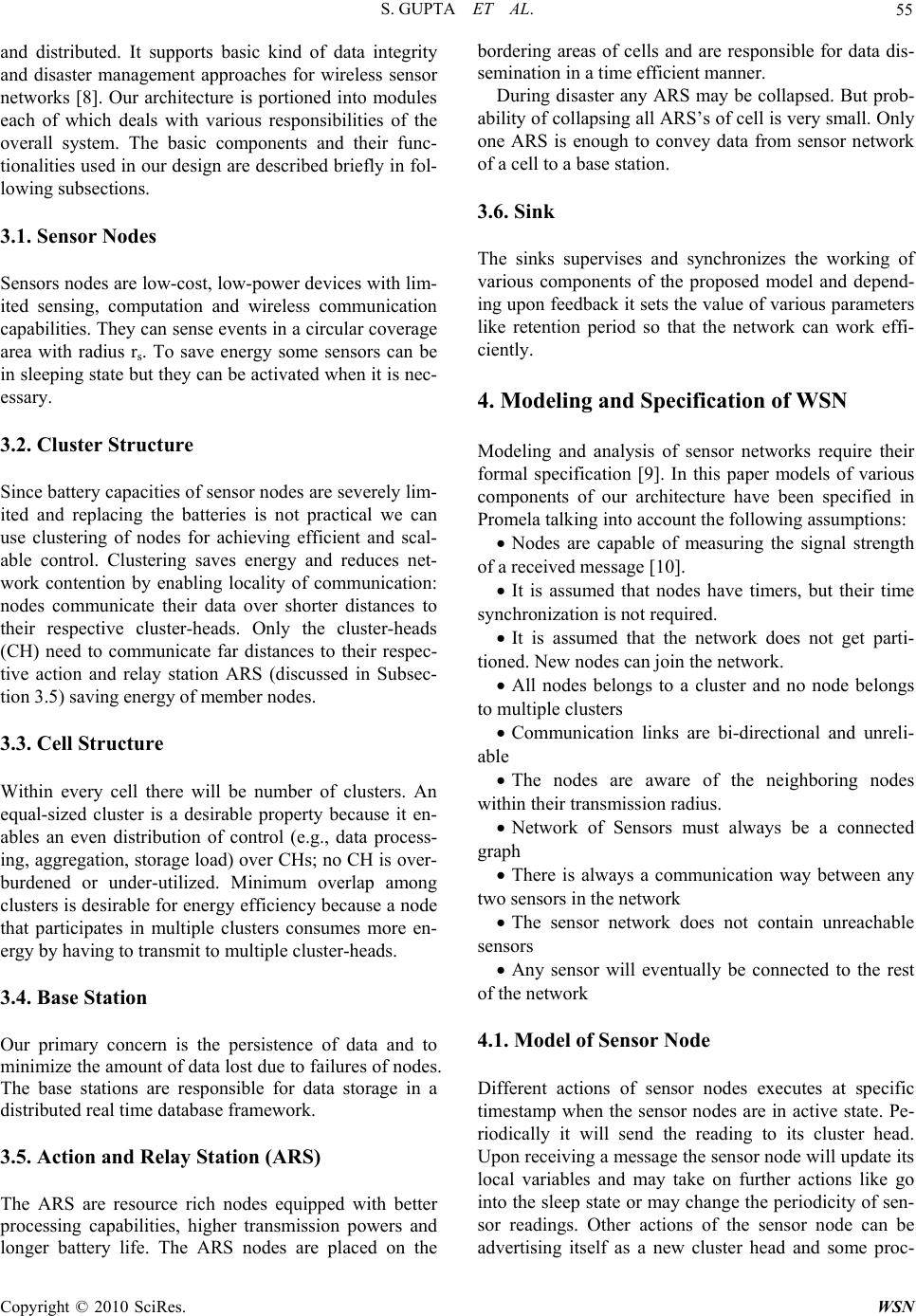
S. GUPTA ET AL.
C
opyright © 2010 SciRes. WSN
55
and distributed. It supports basic kind of data integrity
and disaster management approaches for wireless sensor
networks [8]. Our architecture is portioned into modules
each of which deals with various responsibilities of the
overall system. The basic components and their func-
tionalities used in our design are described briefly in fol-
lowing subsections.
3.1. Sensor Nodes
Sensors nodes are low-cost, low-power devices with lim-
ited sensing, computation and wireless communication
capabilities. They can sense events in a circular coverage
area with radius rs. To save energy some sensors can be
in sleeping state but they can be activated when it is nec-
essary.
3.2. Cluster Structure
Since battery capacities of sensor nodes are severely lim-
ited and replacing the batteries is not practical we can
use clustering of nodes for achieving efficient and scal-
able control. Clustering saves energy and reduces net-
work contention by enabling locality of communication:
nodes communicate their data over shorter distances to
their respective cluster-heads. Only the cluster-heads
(CH) need to communicate far distances to their respec-
tive action and relay station ARS (discussed in Subsec-
tion 3.5) saving energy of member nodes.
3.3. Cell Structure
Within every cell there will be number of clusters. An
equal-sized cluster is a desirable property because it en-
ables an even distribution of control (e.g., data process-
ing, aggregation, storage load) over CHs; no CH is over-
burdened or under-utilized. Minimum overlap among
clusters is desirable for energy efficiency because a node
that participates in multiple clusters consumes more en-
ergy by having to transmit to multiple cluster-heads.
3.4. Base Station
Our primary concern is the persistence of data and to
minimize the amount of data lost due to failures of nodes.
The base stations are responsible for data storage in a
distributed real time database framework.
3.5. Action and Relay Station (ARS)
The ARS are resource rich nodes equipped with better
processing capabilities, higher transmission powers and
longer battery life. The ARS nodes are placed on the
bordering areas of cells and are responsible for data dis-
semination in a time efficient manner.
During disaster any ARS may be collapsed. But prob-
ability of collapsing all ARS’s of cell is very small. Only
one ARS is enough to convey data from sensor network
of a cell to a base station.
3.6. Sink
The sinks supervises and synchronizes the working of
various components of the proposed model and depend-
ing upon feedback it sets the value of various parameters
like retention period so that the network can work effi-
ciently.
4. Modeling and Specification of WSN
Modeling and analysis of sensor networks require their
formal specification [9]. In this paper models of various
components of our architecture have been specified in
Promela talking into account the following assumptions:
Nodes are capable of measuring the signal strength
of a received message [10].
It is assumed that nodes have timers, but their time
synchronization is not required.
It is assumed that the network does not get parti-
tioned. New nodes can join the network.
All nodes belongs to a cluster and no node belongs
to multiple clusters
Communication links are bi-directional and unreli-
able
The nodes are aware of the neighboring nodes
within their transmission radius.
Network of Sensors must always be a connected
graph
There is always a communication way between any
two sensors in the network
The sensor network does not contain unreachable
sensors
Any sensor will eventually be connected to the rest
of the network
4.1. Model of Sensor Node
Different actions of sensor nodes executes at specific
timestamp when the sensor nodes are in active state. Pe-
riodically it will send the reading to its cluster head.
Upon receiving a message the sensor node will update its
local variables and may take on further actions like go
into the sleep state or may change the periodicity of sen-
sor readings. Other actions of the sensor node can be
advertising itself as a new cluster head and some proc-